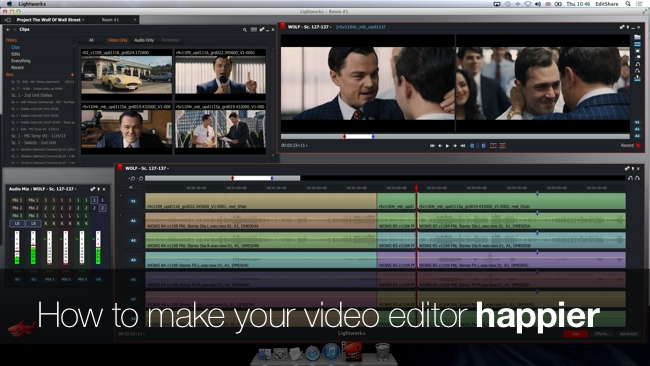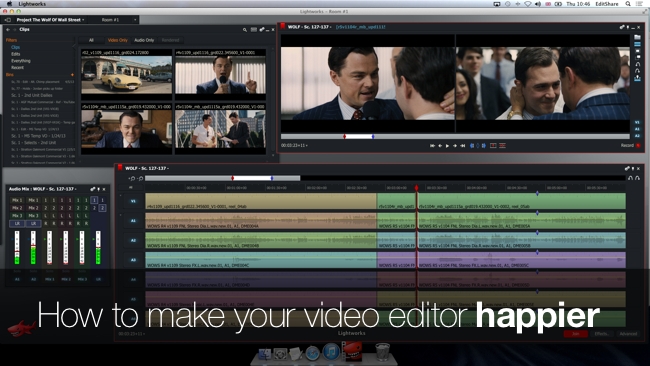
 How to make editors happy
How to make editors happy
RedShark Replay: Always good to read editor and blogger Jonny Elwyns' handy list for shooters and camera ops on the many ways to not only keep their editors happy, but make them even happier.
As any experienced editor will tell you, after years of sifting through hours and hours of footage (some of it good, some of it bad, some of it very ugly), there are a few key things that anyone working behind the camera can do that make our lives much easier, the project far better, and the final result something we can all be proud of.
Of course, it's very easy for editors to turn into armchair critics. They didn't get up at 5 am to make the sunrise or drag heavy gear half way up a mountain, battling the elements just to get the perfect shot. But we do have the benefit of the perspective gained by leisurely skimming through the results of your hard graft. So here are 11 suggestions for things every editor wishes every camera operator always did, and hopefully they'll improve what you get in the can, and improve the life of editors everywhere.
The first and last suggestions are probably the most important!
- Shoot for the edit - Think in terms of sequences and storytelling. Make sure you've got an establishing wide, an interesting reveal, close ups, movement etc. If an interviewee mentioned a specific location, item, or view, try to grab that if you can. Also think in terms of triplets. Three shots most often make for a nice sequence of cutaways - two, not so much.
- Always roll - It's the 'bad bits' that we often use - re-focuses, lens whacking, snippets of background audio for filling in silences, etc. - so please don't wave your hand in front of the camera to say that it's no good. We might have a use for it anyway.
- Don't always roll - Editors don't love it when they have to copy, ingest, transcode and organise lots of footage that then turns out to be someone's feet, the inside of a car door, lens caps or other random things. Obviously, this isn't intentional, but if you know it's happened, please weed out the clip if you can.
- Metadata matters - Make sure that the reel names and timecode on your camera are set correctly and that they increment with each new card, tape or disc. The more information you can supply us the better. If you're keeping logging sheets or camera reports, please know we do actually look at them!
- Fix it in Camera - Ensuring your white balance and colour temperature are set correctly is extremely helpful. Not only is this a pretty basic element for a professional cameraman to get right, it can be sometimes very difficult to fix in the grade later on (if the project is lucky enough to have a grade), especially under more exotic lighting conditions, for example inside a factory or under-ground parking garage. And if you want to really go wild, actually shoot a colour chart.
- Don't talk - Whilst you're filming, you might be thinking, ''they'll never use the sound on this.'' Well, we certainly won't be able to if you're chatting away. The atmos, sync sound, or wireless mic could be getting something that turns out to be really useful. Plus, you don't want to get caught saying something you shouldn't about anyone else - not least the producer or director who might have sat in the edit, too!
- Don't be lazy - Use a tripod for static shots. Of course, some times things get a little 'run and gun' on set and have to be grabbed in a hurry, but there's only so much Warp Stabiliser can do.
- Hold your shots - Nothing says 'amateur' more than a whole series of cutaways that are too short to use. Hold your shots for at least a long 3 count or until you are really, really bored and then, and only then, move on. This is especially true of photographers turning to video for the first time. Just because you've framed the shot, and mentally 'got it', it doesn't mean you have actually captured enough of it on video to use in the edit.
- Nail your pulls - When doing some nice rack focus pulls, please make sure you actually nail one. Often footage will contain several failed attempts with none of them quite making it. If in doubt, just set it in focus, swish it out of focus and let the editor reverse the shot in post.
- Don't be on a track to nowhere - The ubiquitous nature of sliders make for an easy win in terms of adding a bit of extra production value to your shoot. But just make sure you're sliding from-or-to something. Tell a story in the shot by what is being revealed, moved towards (or away from). And if you're going to shoot a wide and a close version, please make sure you're tracking in the same direction and at the same speed for both. That way we can cut in (or out) and it will match perfectly.
- Ask for feedback - Come in and talk to us; although we 'work with computers', we actually like seeing people, too. Come in and review the footage to get feedback and improve what you shoot. We'll be able to tell you what worked out really well and what didn't - from the hindsight laden tranquility o' the edit suite. If you can't physically come in and look at footage in the edit suite, then drop the editor an email, ask them for what was good, what worked, what didn't work, etc. Editors prefer to work with an embarrassment of riches rather than having to work to cover your embarrassments.
Tags: Production


Comments